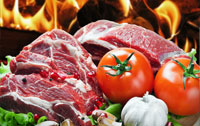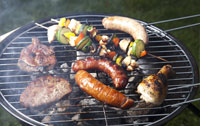Food Safety
Experts agree that there are four important steps for keeping your food safe to eat, and keeping your family healthy – Clean, Separate, Cook and Chill.
Clean
Your kitchen has the greatest potential for bacterial contamination that could lead to illness. That is why it is so important to wash your hands, cooking utensils, kitchen surfaces (countertops and cutting boards), and even your fruits and vegetables.
Separate
Even if your kitchen and utensils have been cleaned properly, raw food can contain bacteria that can spread to other foods if not separate properly. Meat, poultry, eggs and seafood should be kept separate from vegetables, dairy and ready-to-eat foods. Use different utensils for each food you are preparing and clean them often between uses. Make sure that raw foods containing juice are package properly so that they do not leak or drip, causing contamination.
Cook
Improperly cooked food can cause bacteria to survive through the cooking process and can result in serious illness. Make sure food reaches the proper temperature to ensure meat has been thoroughly cooked. Make sure cooked food stays warm until it is served.
Chill
Leftovers should be refrigerated within two hours, and as little as one hour during the heat of the summer. Never defrost foods by leaving them in the countertop.
Fridge and freezer storage
All foods have an expiry date – even when they are frozen. Frozen foods continue to deteriorate while in the freezer, but at a much slower rate. No food should be kept in the freezer for longer than 12 months. Some foods can expire in the freezer after as little as one month. Refrigeration times can vary greatly between types of food. Visit the BeFoodSafe.ca Storage Chart for guidelines on proper storage times for food in your fridge and freezer.
Cooking guidelines
To keep meat safe for consumption, it must reach an optimal temperature during the cooking process. Undercooked meat can contain bacteria that can cause severe illness. Shell fish that does not open during the cooking process should be discarded immediately. Visit the BeFoodSafe.ca Cooking Chart for guidelines on proper cooking temperatures.
Microwave Safety
Microwaves are a quick, easy way to heat food but they also contain hidden dangers that can cause harm to your family. Keep these tips in mind to keep your family safe from microwave danger.
- Never place a microwave higher than countertop height. Removing scalding food from a microwave that is above your head is extremely dangerous.
- Sealed containers and closed packaging can contain steam that is hot enough to cause severe burns including popcorn bags and microwave meals.
- Microwave containers can be extremely hot to the touch. Use oven mitts or pot holders.
- Microwaves do not always cook food evenly. Make sure that all portions of the food have been cooked through before consuming.
- Never use containers or wrappers that are not approved for use in the microwave. Plastic wrap and plastic or Styrofoam containers can melt and contaminate your food.





